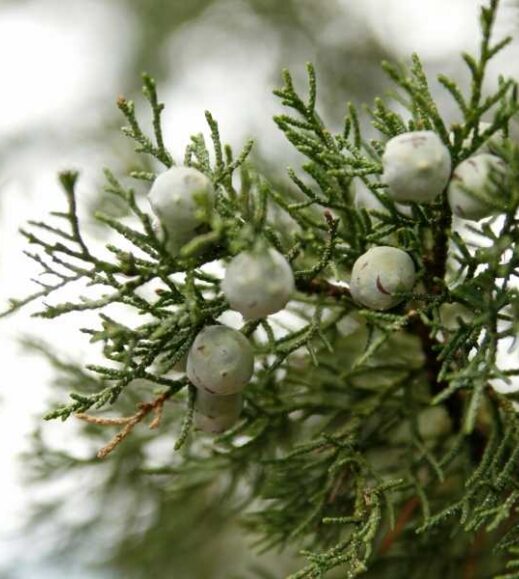Propagate | Soil | Light | Water | Temperature | Humidity | Potting | Pruning | Fertilize | Pest Control | FAQs
The Alligator juniper, also known as Juniperus deppeana or Checkerbark juniper, is an evergreen tree that grows in the southwestern United States and northern Mexico. It is native to Arizona, New Mexico, Texas, and California deserts. The plant typically reaches 10-25 feet tall with a 15-foot spread. Its bark is distinctive with its deep furrows and ridges, which give the tree its common name of "alligator" juniper. The bright green foliage turns a darker blue-green color in winter and has a pleasant smell when crushed. Alligator juniper provides excellent shade and plenty of bird habitat and wildlife benefits.
Alligator juniper is a fairly easy plant to care for and can thrive in many different kinds of soil, but it prefers well-drained, sandy loam. The tree is tolerant of cold and heat, making it an ideal choice for gardeners in areas with extreme temperatures. However, the plant does need occasional pruning to keep its shape and size. Alligator juniper is also very drought tolerant once established, so it doesn't require much watering or fertilizer.
This Alligator juniper care guide will provide all the information you need to grow and care for this unique plant in your yard or garden. Here, you will find answers to all the common questions regarding growing and caring for Alligator juniper, including planting tips, pruning requirements, watering needs, and more.
Do Alligator juniper flower? What color is the Alligator juniper flower?
Alligator juniper does produce flowers, but they are not very noticeable. The inconspicuous greenish-yellow flowers are produced in the late spring and early summer. The flowers are followed by blue-gray berries that are attractive to birds.
When to plant Alligator juniper plant?
The best time to plant an Alligator juniper is in the late winter or spring. This will give the tree plenty of time to become established before the onset of summer and its hot temperatures. Alligator juniper can tolerate cold temperatures better than heat, so planting in late winter or early spring is recommended.
Types of Alligator juniper: what are the recommended varieties of Alligator juniper plants?
There are several varieties of Alligator juniper that can be grown, including:
- The Juniperus deppeana var. Deppeana: the most widespread type of alligator juniper with its easily-distinguishable bark features.
- Juniperus deppeana var. sperryi (Sperry's juniper) is a highly threatened species of alligator juniper that has been classified as critically endangered.
- Juniperus deppeana var. robusta: Despite its endangered status, this juniper tree is still harvested for firewood and lumber.
- Juniperus deppeana var. chinesis: Known as Chinese juniper, this is mostly used for creating bonsai.
- Juniperus deppeana var. pachyphlaea: A sweet-fruited juniper, an aromatic evergreen shrub, has small round berries that offer a delightful fragrance in the air.
- Juniperus deppeana var. zacatecensis: This rare variety of alligator juniper is being threatened due to the destruction of its natural habitat through deforestation.
How to plant Alligator juniper?
When planting an Alligator juniper, choosing a well-drained spot with plenty of sun is important. You can plant the tree directly in the ground or a container, keeping it at least 10 feet away from structures. Choose an area with little grass or vegetation competition for the best results.
When planting in the ground, dig a hole twice as wide and just as deep as the root ball of the Alligator juniper. Place the tree in the hole, ensuring it is level with the surrounding soil. Backfill with soil and water thoroughly to ensure good root-to-soil contact. Planting in a container requires similar instructions but should also include the addition of well-draining potting soil.
Alligator juniper soil requirements: What is the best soil for the Alligator juniper plants?
Alligator juniper does best in well-drained soils and sandy loam. The tree is tolerant of a variety of soil but prefers slightly acidic clay or loam soils with good drainage. It is also important to ensure that the planting site has adequate sunlight and protection from cold winter winds.
Adding amendments and enhancers can also be beneficial to Alligator juniper. Organic matter such as compost or manure can be added to the soil before planting. Nutrient enhancers, such as bone meal and rock phosphate, can also be added for additional nutrition.
Alligator juniper light requirements: How much light does Alligator juniper plant need?
Alligator juniper does best in full sun but can tolerate partial shade. It needs at least 6 hours of direct sunlight per day to thrive, so it is important to choose a location with plenty of light.
When planting in containers, it should be placed in an area that receives full sun for most of the day. Shade cloth or other shading materials can protect the tree from the intense afternoon sun.
Alligator juniper water requirements: How often should Alligator juniper trees be watered?
Alligator juniper needs consistent moisture but will tolerate some drought. It is important to provide regular deep watering during establishment, especially in hot and dry climates.
Once established, the Alligator juniper should be watered deeply once or twice weekly during the spring and summer. It can be watered less frequently during winter but requires occasional deep watering to prevent drought stress.
Plant grow light can be used to supplement the sun's light, especially during winter months. LED and fluorescent lights can provide additional light for the Alligator juniper tree.
Alligator juniper water requirements: How often to water the Alligator juniper plant?
Alligator juniper needs consistent moisture but will tolerate some drought. It is important to provide regular deep watering during establishment and at least once per week during the spring and summer months. It can be watered less frequently during winter but still needs occasional deep watering to prevent drought stress.
The soil should be kept evenly moist and never allowed to dry out completely or become soggy. Overwatering can cause root rot and lead to plant death, so monitoring the soil moisture and adjusting watering accordingly is important. Watering in the morning is best, as it gives the Alligator juniper time to absorb water before nightfall.
An irrigation system can be used to provide consistent watering for Alligator juniper. Drip irrigation is ideal, as it delivers water directly to the plant's root zone and prevents moisture loss from evaporation. Soaker hoses can also be used, though they are less efficient than drip systems.
Alligator juniper temperature range: What temperature can Alligator juniper tolerate?
Alligator juniper is a cold, hardy tree and can tolerate temperatures as low as -10°F (-23°C). It should be protected from extreme winter winds, however, and shelter belts or windbreaks can help to reduce chilling injury.
During summer, Alligator juniper prefers temperatures between 60-80°F (15.5-26.6°C). It should be grown in partial shade and kept consistently moist in hot climates to prevent heat stress.
To protect plants during bad weather, You can use a greenhouse, cold frame, and plant protective covers to protect Alligator juniper from extreme temperatures, frost, and wind damage.
Alligator juniper humidity: Do Alligator juniper like humidity?
Alligator juniper prefers a moderate humidity level and does not like very dry or humid conditions. It should be planted in areas that receive morning sun or filtered light in arid climates to reduce the risk of drought stress.
Alligator juniper should be given ample air circulation in humid climates to prevent fungal diseases. Pruning and thinning out the dense canopy of branches can also reduce humidity and allow more air circulation.
Use a humidifier or misting system to maintain the humidity of plants around your Alligator juniper, use a humidifier or misting system. This will create a microclimate of higher humidity around your plants which can help to protect them from extreme temperatures and drought stress.
Alligator juniper plant propagation: How to propagate Alligator juniper plant?
propagating plants, including cuttings, grafting, air layering, and seed germination.
Propagate Alligator juniper plant from seed
Alligator juniper is a cypress species that do not reproduce true from seed. Seeds from the tree can be gathered in the fall when they are ripe, though germination rates vary widely.
The best way to propagate Alligator juniper is from cuttings or air layering. To take a cutting, use a sharp knife or pruner to remove a 4-6 inch (10-15 cm) branch from an actively growing area of the tree. Make sure to make the cut just below a node and include some leaves on the cutting. cut
Place the cutting in moistened potting soil and water regularly, ensuring it does not dry. It can take several weeks for the cutting to take root, so be patient and monitor the soil's moisture levels.
Once established, the Alligator juniper can be grown in various climates and require minimal care. With regular watering during establishment and proper air circulation, this species of cypress can thrive in many different environments. Proper pruning and pest control are also important to keep the plant healthy. Thanks for reading!
Propagating Alligator juniper plant by cutting or layering:
When it comes to propagating Alligator juniper plants, there are two primary ways of doing so — through cuttings and layering. Cuttings are the most common method used by gardeners, as they require very little effort and time. To propagate an Alligator juniper by cutting:
- Select a healthy branch and make sure it has several sets of leaves.
- Cut the branch into pieces with sharp pruning shears or gardening scissors, each at least six inches long and no more than two-thirds of an inch thick.
- Remove all but the top set of leaves from each cutting and dip them in the rooting hormone.
- Plant your cuttings in a pot or container filled with soil and peat moss, ensuring the cut end of the cutting is planted at least an inch beneath the surface.
- Keep the soil moist but not soggy, and maintain a warm temperature — around 70 degrees Fahrenheit — to encourage root growth.
Propagating Alligator juniper plant by division
Propagating your Alligator juniper plant by division is another great option. This method requires a more seasoned approach, as the plant must be removed from the ground and carefully split into several pieces that can then be replanted. To properly divide an Alligator juniper, select two or three viable portions of the main stem and root ball and use a shovel or spade to separate them. Take care not to disturb the root system too much when digging around it, as this can cause significant damage and hinder the plants' chances of thriving post-propagation. Once you've divided the plant into multiple parts, replant them in an area with soil that is well-draining, nutrient-dense, and moist. Water your newly planted Alligator juniper plants regularly and keep them in a location that receives plenty of sunlight — at least six hours per day.
Propagating Alligator juniper plant by air layering
Air layering is another great way to propagate Alligator juniper. This method requires a bit more effort but results in healthier cuttings that are better adapted to the environment they will be planted in. To air layer, your Alligator juniper, select a healthy branch and make an upward-angled cut just below a node (or leaf) on the stem. Wrap the cut portion of the branch in moist sphagnum moss and tightly wrap it in plastic or aluminum foil to keep the moisture in. Make sure you secure this "mini greenhouse" with tape, as it will need to stay in place for several weeks while roots form. Once ample roots have formed, sever the branch below the plastic wrap and replant. Caring for Alligator juniperCaring for your newly propagated juniper plants is relatively simple. Like all plants, be sure to water them regularly — at least once a week — depending on your climate and soil conditions. Additionally, ensure they have at least six hours of direct sunlight daily. Prune your Alligator juniper plants when they need it, paying special attention to dead or diseased branches. Finally, fertilize your plants once every two months during the growing season to ensure optimal growth.
Potting Alligator juniper plant
Alligator juniper plants can also be grown in containers for decoration or other purposes. To pot your Alligator juniper, select a deep and wide container to contain its root system (at least 12-16 inches in diameter). Fill the deep and wide container bottom with a couple of inches of gravel to help ensure good drainage; then add soil — preferably a mixture of potting soil and compost — that is well amended with organic material. Once the container is filled, place your Alligator juniper and backfill it with additional soil around the root ball. Water thoroughly and be sure to water regularly when needed; also, ensure that your container has adequate drainage holes in the bottom to allow excess water to
It is important to select the correct pot size or container for your Alligator juniper. The ideal pot size should be larger than the plant's root ball, allowing enough space for new growth and development. Additionally, use a lightweight container that is easy to move since Alligator junipers can become quite heavy when planted in large pots.
How to prune Alligator juniper plant?
Pruning is an essential part of caring for your Alligator juniper plant. Pruning helps to maintain its shape and form, as well as encourages healthy new growth. To properly prune your Alligator juniper, use sharp gardening shears or a pruning saw to remove any dead, broken, or diseased branches at the base of the main stem. Cut back any errant or stray branches that are growing outward, as these can take away from the overall shape of your plant. Prune off any secondary shoots growing upward and thinning out the canopy to allow more light and air circulation. Finally, prune off any dead leaves or needles to improve the appearance of your Alligator juniper and help it stay healthy.
How to fertilize Alligator juniper plant?
Fertilizing your Alligator juniper is important in keeping it healthy and thriving. Fertilizers help to replenish lost nutrients in the soil, improving the overall health of your plant. When fertilizing, use a balanced fertilizer with equal nitrogen, phosphorus, and potassium for the best results. Apply the fertilizer once every two months during the growing season, and water thoroughly afterward. Be careful not to overfertilize, as this can lead to the burning or death of your plant.
Choose a high-quality fertilizer with a balanced NPK (nitrogen, phosphorus, and potassium) ratio to fertilize your Alligator juniper. Some of the plants also benefit by adding appropriate soil amendments.
Common Alligator juniper diseases and how to manage Alligator juniper disease?
Alligator juniper plant is prone to a few common pests and diseases, including:
Powdery mildew: This is a fungal disease that causes white, powdery spots on the leaves and stem of your Alligator juniper. To control it, prune off any infected branches and spray with a fungicide.
Canker: This bacterial or fungal infection can cause the bark of your Alligator juniper to become darkened and cracked. To control it, prune off any infected branches and spray with a fungicide.
Rots: These are caused by fungus or bacteria that can kill the roots of your Alligator juniper plant. To prevent them, ensure your soil is well drained and aerated, water only when necessary, and avoid overwatering.
In case of an outbreak:
- Use good quality insecticides and fungicides to control the diseases and pests.
- Read the directions on the label carefully before use.
- Follow all safety precautions when dealing with pesticides, such as wearing protective clothing and goggles.
Ten reasons to grow Alligator Juniper
1. Versatile and Attractive: Alligator Juniper is a highly versatile and attractive evergreen tree that can be used in various ways. It makes an excellent focal point, accent plant, r windbreak for any outdoor space.
2. Low Maintenance: Alligator junipers are low maintenance and don't require much pruning or fertilizing once established. This makes them an ideal choice for busy gardeners who want to keep their landscapes neat without spending too much time on upkeep.
3. Long-Lived: Alligator junipers have long lifespans, with some specimens living up to 150 years!
4. Adaptable: Alligator junipers are very adaptable and can survive in both hot and cold weather.
5. Disease Resistant: Alligator junipers are resistant to disease, making them a great choice for gardeners who want a low-maintenance tree that will last for generations.
6. Hardy: Alligator junipers can tolerate dry climates and survive in poor soil conditions.
7. Fast Growing: Alligator junipers are fast-growing evergreens, reaching heights of 12-15 feet in just 3-4 years.
8. Easy To Transplant: Alligator junipers have shallow roots, which makes them easy to transplant to another area of your landscape if needed.
9. Beautiful Foliage: The attractive foliage of the alligator juniper tree makes it a great choice for any landscape.
10. Wildlife Friendly: Alligator junipers provide food and shelter to wildlife, including birds, squirrels, and other small animals. This makes them an ideal addition to any garden looking to attract more wildlife!
Takeaway on how to grow and care for Alligator juniper
When it comes to growing and caring for Alligator juniper, the most important thing is to create a healthy environment that meets the plant's needs. Make sure your soil has good drainage and avoid overwatering. Provide adequate sunlight and fertilize regularly with a balanced fertilizer. Be mindful of common pests and diseases, such as powdery mildew or canker, by pruning off infected branches and spraying with an appropriate fungicide or insecticide when needed. With proper care, you can enjoy the unique beauty of this evergreen shrub for years to come.
Explore our plant growth and care guides collection to add more plants to your garden.
If you're new to gardening or a seasoned pro, join our supportive AgFunnel community of gardeners. Share a picture of your garden and receive support from fellow plant lovers. Happy gardening.
FAQs
What is Alligator juniper?
The Alligator juniper is an evergreen shrub native to the southwest United States. Its distinguishing feature, however, comes in its unique bark, which resembles alligator skin - thus, its namesake! The foliage of this plant consists of dark green scales with cheerful red tips. It typically grows up to 12 feet in height and is popular for landscaping projects.
Where to put Alligator juniper?
Alligator juniper should be planted in an area that receives full sun. It prefers well-draining soil and can tolerate both hot and cold temperatures. For best results, give the plant plenty of space to grow and avoid overcrowding with other plants.
How often should Alligator juniper be watered?
Alligator juniper should be watered at least once weekly during hot, dry weather. Avoid overwatering the plant; it prefers the soil to be kept slightly moist but not saturated. During winter, watering should only be done during unusually dry weather.
How to get Alligator juniper to bloom?
Alligator juniper blooms in late spring to early summer when it produces clusters of small, white flowers. To encourage blooming, ensure the plant receives adequate sunlight and regularly fertilizes using a balanced fertilizer. Deadhead spent flowers to prevent seed production and promote better flowering for the next season.
Does Alligator juniper plant like sun or shade?
Alligator juniper prefers full sun but can tolerate some shade. It should be planted in an area with at least 6 hours of direct sunlight per day and placed away from trees or other plants that might block the light. Make sure to water regularly during hot, dry weather and provide enough space for the plant to grow.
Is the Alligator juniper plant annual or perennial?
Alligator juniper is a perennial plant that can live for many years with proper care. Its compact size means it doesn't require much space, and only minimal maintenance is needed. Regularly water and fertilize the plant to maintain its health and encourage blooming. With a bit of love, your Alligator juniper can bring color.
Does the Alligator juniper plant come back every year?
Yes, the Alligator juniper is a perennial plant that can return yearly with proper care. Make sure to water and fertilize regularly and provide adequate sunlight. Giving your plant enough love will reward you with beautiful foliage and clusters of white flowers every spring.
Are Alligator juniper plants toxic to cats?
No, Alligator juniper is not toxic to cats or other animals. The plant can provide important habitat for pollinators and other wildlife. However, keep your pets away from any fertilizers or pesticides you may use on the plant, as these can be hazardous if ingested.
Are Alligator juniper plants toxic to dogs?
No, Alligator juniper is not toxic to dogs or other animals. The plant can provide important habitat for pollinators and other wildlife. However, keep your pets away from any fertilizers or pesticides you may use on the plant, as these can be hazardous if ingested.
Are Alligator juniper plants toxic to pets?
No, Alligator juniper is not toxic to pets or other animals. The plant can provide important habitat for pollinators and other wildlife. However, keep your pets away from any fertilizers or pesticides you may use on the plant, as these can be hazardous if ingested.
How cold can Alligator juniper plants tolerate?
Alligator junipers are hardy and can tolerate both hot and cold temperatures. During extreme cold spells, it's best to provide extra protection with a layer of mulch or a winter cover. The plant should not be exposed to freezing temperatures for extended periods as this can damage the foliage.
How often to water the Alligator juniper plant?
Alligator juniper should be watered at least once weekly during hot, dry weather. Avoid overwatering the plant; it prefers the soil to be kept slightly moist but not saturated. During winter, watering should only be done during unusually dry weather.
When to stop watering the Alligator juniper plant?
Alligator juniper should be kept from being watered regularly during the winter months. It prefers to stay slightly moist but not saturated; allowing the soil to dry out between waterings will help prevent root rot and disease. Stop watering the plant when temperatures drop in autumn and only resume during unusually dry weather.
When to fertilize the Alligator juniper plant?
Fertilizing your Alligator juniper should be done in late winter or early spring. As the plant begins to bloom and leaf out, it will need a gentle application of fertilizer to support its growth. Use a balanced slow-release fertilizer specially formulated for conifers and other evergreen plants. Avoid overfertilizing; too much fertilizer can lead to weak growth and discoloration.
Can the Checkerbark Juniper Plant be included in a Kids' Gardening Kit?
The Checkerbark Juniper Plant is a great addition to a kids' gardening kit for you. Its unique, colorful bark and low maintenance make it an ideal choice for young gardeners. With adult supervision, kids can learn about plant care and enjoy the beauty of this unique juniper plant.
Where to buy the Alligator juniper plant?
Alligator juniper plants can be purchased from many local garden centers and nurseries. They may also be available online through specialty retailers. It's best to purchase a well-established plant with plenty of healthy green foliage; these will establish faster and reward you with more blooms in the spring.

How to master gardening? Download these essential home and gardening ebooks today!














